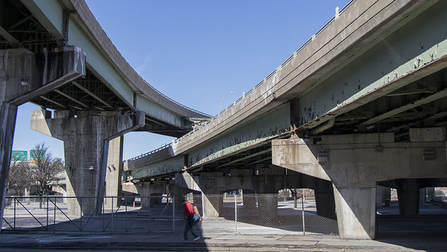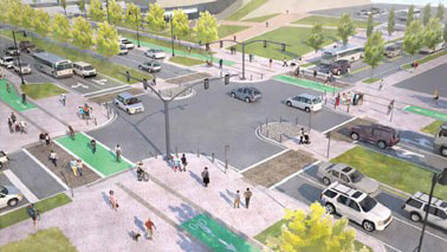The Future of I-81: Concrete Skyway or Green Community Grid
7/9/2018
By Alma Lowry

I-81 Underpass (Daily Orange)

Community Grid (NYS DOT)
Although Atlantic States Legal Foundation has worked throughout the United States and across the world, we have a special concern for Syracuse, our host city. For more than five years, Syracuse has been debating what to do with the aging I-81 highway viaduct, which runs through the heart of the city. Current proposals include rebuilding the elevated highway to meet modern safety standards, putting the highway into a tunnel, or demolishing the viaduct and replacing it with a revitalized community grid. For both environmental and social justice reasons, Atlantic States Legal Foundation (ASLF) supports the community grid option and will be looking for opportunities over the coming year to advocate for this result.
The current highway is a textbook case of social and environmental injustice. I-81, like other highway projects of its era, was designed to provide easy access to and from the suburbs and to “cure urban blight” by displacing “unsightly” and impoverished minority communities. In Syracuse, the disrupted community was the mostly African-American 15th Ward. Highway construction required demolition of hundreds of homes, divided the community, and left acres of undevelopable wasteland under the viaduct. The remaining residents were left in the shadows of the highway and suffered from air pollution, noise pollution, and other environmental ills generated by tens of thousands of cars, trucks, and buses that traversed the highway daily.
The community grid alternative will begin to fix this problem. With the community grid, through traffic will be rerouted onto an existing ring road reducing traffic, particularly truck traffic, through the heart of Syracuse. This will reduce air and noise pollution. Remaining traffic will be dispersed rather than forced onto a limited number of congested routes. And the visual blight of this massive concrete structure, which looms over the community, will be removed, opening space for sunshine, green space, community amenities, and new businesses.
From an environmental perspective, the I-81 corridor has always been a serious problem, generating some of the most persistent and difficult water quality issues in the watershed. The area around I-81 and the connecting NY-690 generates 66 million gallons of runoff annually and frequently contributes to combined sewage discharges into local creeks. The community grid would eliminate the 30 acres of impervious area created by the viaduct itself and allow better, greener stormwater management on 260 acres adjacent to the highway. Street level stormwater systems can emphasize infiltration and capture rather than simply sending runoff into waterways via combined sewers or to the regional wastewater treatment plant for expensive and unnecessary treatment. The community grid would allow development similar to that found in Syracuse’s Connective Corridor, which dramatically reduces stormwater runoff while providing bike paths, pervious parking spaces, and flowering infiltration beds. Rather than a concretized community, the former 15th Ward could enjoy a walkable, bikeable and green neighborhood.
ASLF is committed to seeking innovative and practical solutions for environmental issues. The community grid alternative offers unlimited opportunities for creative ways to manage stormwater, expand urban greenspace and move toward a more resilient, sustainable Syracuse. We look forward to finding ways to spread this message in the coming year and to help build the Green Community Grid in the future.
The Future of I-81: Concrete Skyway or Green Community Grid Read More »
